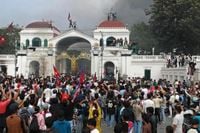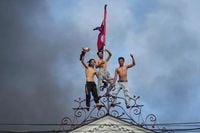On the tenth anniversary of Nepal’s constitution, the nation found itself at a crossroads—one that few could have predicted when the Federal Democratic Republic was first declared in 2015. What had started as a hopeful experiment in democracy, forged through decades of struggle and the sacrifice of nearly 17,000 lives, now faces its sternest test yet: a youth-driven revolution that toppled the government in a matter of hours and has left the old order scrambling for answers.
The interim government, led by former Chief Justice Sushila Karki, marked Constitution Day on September 19, 2025, in the shadow of the Gen Z uprising that had rocked the country just days earlier. According to OnlineKhabar, this constitution was meant to be the capstone of Nepal’s long fight for democracy, promising stability, equality, and inclusion. Yet, within a decade, calls for its replacement or major amendments have grown louder, coming not only from civil society and political parties but especially from the country’s restless youth.
The backdrop to this upheaval is a nation where the promise of democracy has repeatedly collided with harsh realities. Nepal has cycled through twelve prime ministers in just seventeen years, with power concentrated among a trio of senior leaders—KP Sharma Oli, Pushpa Kamal Dahal "Prachanda," and Sher Bahadur Deuba—who have formed and dissolved coalitions with dizzying regularity. The absence of a robust opposition and the persistence of dynastic politics have left many Nepalis, especially the young, feeling excluded and disillusioned.
Economic frustrations have only deepened the sense of betrayal. Youth unemployment hovers around 20 percent, and, as OnlineKhabar reports, nearly 6.8 million Nepalis have sought work abroad since the early 1990s, a staggering number for a country of 30 million. More than 6 million now labor in foreign lands—some as construction workers in the Gulf, others as mercenaries in Ukraine, or as seasonal migrants in India. Their remittances make up nearly a third of Nepal’s GDP, while 80 percent of those who remain at home toil in informal sectors with little security.
In August 2025, the contrast between the struggles of ordinary Nepalis and the ostentatious lifestyles of political elites’ children became a flashpoint. Social media was flooded with images: young migrants, faces etched with uncertainty, boarding flights at Kathmandu airport, set against the backdrop of luxury cars, designer clothes, and extravagant vacations flaunted by the privileged. The slogan "Hamro bau Khadi ma Timro bau gaadi ma"—our father sweats in the Gulf while yours cruises in cars—captured a generation’s anger at deepening class divides and endemic corruption.
Then came the tipping point. Following a Supreme Court order, Prime Minister KP Sharma Oli banned 26 social media apps, severing vital connections for young migrant workers and cutting off Gen Z’s digital lifelines. For a generation raised online, it was the last straw. Protests erupted, first in the streets, then across cyberspace. As Republica details, what began as outrage over corruption, censorship, and broken promises quickly morphed into a full-blown digital uprising on September 8 and 9, 2025.
What set this revolution apart was its structure—or, more accurately, its lack thereof. There were no charismatic leaders, no party banners, no central committees. Instead, coordination flowed through a Discord server called Youths Against Corruption, where thousands of young Nepalis debated, argued, and eventually reached consensus. Over seven thousand users voted to nominate a former chief justice as interim prime minister, propelling Sushila Karki to the helm of an interim government.
The uprising’s speed and ferocity stunned the old guard. Within forty-eight hours, the government collapsed. But the cost was steep: nineteen young protesters were shot dead in the initial chaos, and the death toll has since surpassed seventy. Parliament, the Supreme Court, and the iconic Singha Durbar were set ablaze. Kathmandu’s night was pierced by sirens and the orange glow of burning buildings. As Republica observed, the city filled with smoke, disbelief, and one persistent question: Who was leading this?
The answer, unsettling to many, was simple: no one, and everyone. The movement’s decentralized nature confounded those accustomed to hierarchical power. As rumors swirled of “foreign hands” orchestrating the chaos, the reality was that thousands of young people had found a new way to organize—one that owed more to networked collaboration than to command and control. As British political thinker Carne Ross has argued, this was a “leaderless revolution,” a prototype for how democracy might evolve in the digital age. Ross, cited by Republica, contends that “both representative democracy and capitalism have failed to address the growing crises of inequality, environmental collapse, and political disillusionment… Ordinary people must take responsibility for creating change.”
For Nepal’s Gen Z, digital spaces like Discord became the new public squares. Here, consensus was forged not through decrees but through dialogue—messy, slow, and profoundly human. The movement’s discipline was not imposed by fear or hierarchy but emerged from participation and shared purpose. As Republica notes, “their trust flows sideways through transparency, not upward through hierarchy.”
The old order was left grasping for familiar villains—a mastermind, a hidden hand, a single leader to blame or jail. But the leader they sought was the network itself: transparent, collective, and alive. Technology, often maligned for eroding community, in this instance deepened it, connecting outrage to empathy and solitude to solidarity. The state found itself powerless to stop a movement that had no head to cut off, no central figure to silence.
Yet, as OnlineKhabar points out, Nepal’s fledgling democracy—emerging from 240 years of monarchy—is still learning to institutionalize constitutionalism and the rule of law. The Gen Z movement has sparked urgent debates: Should Nepal adopt a directly elected executive, as some youth demand, or stick with the parliamentary system? How can leadership be made more meritocratic and representative of the country’s diverse regions and communities? And crucially, how can the spirit of constitutionalism be revived so that the ideals of democracy—stability, inclusion, and justice—are not just words on paper but lived realities?
For now, the interim government faces the daunting task of channeling this energy into meaningful reform. The youth demand a government that is transparent, people-centric, and genuinely accountable—one that breaks with the corruption, nepotism, and bureaucratic inertia of the past. As the country debates constitutional amendments and the shape of its future, the world is watching. Nepal’s Gen Z has shown that power can circulate, not just descend; that consensus can govern as effectively as charisma once did; and that, in the networked century, revolutions may be written not in manifestos, but in code.
As the smoke clears over Kathmandu, one thing is certain: Nepal’s democracy will never be the same. The challenge now is to ensure that the hope and courage of this new generation are not lost but become the foundation for a more just and inclusive republic.






